China Railway High-speed (CRH) is a high-speed rail service operated by China Railway.

The Capital Airport Express of the Beijing Subway, also known by the initials ABC, Airport Beijing City, is an airport rail link from Beixinqiao station to the Beijing Capital International Airport. The line became operational on July 19, 2008. On subway maps, the Capital Airport Express' color is purplish gray .

The CRH3 Hexie is a version of the Siemens Velaro high-speed train used in China on the Beijing–Tianjin intercity railway line, Wuhan-Guangzhou Passenger Dedicated Line, Zhengzhou-Xi'an Passenger Dedicated Line and the Shanghai–Nanjing intercity railway. It is capable of service speed of 380 km/h (236 mph) as the very similar Velaro E used in Spain, but, similarly to the Sapsan, it is 300 mm (11.8 in) wider to take advantage of a more generous structure gauge and thus be able to fit in more seats in a 2+3 layout.

The Shaoshan 1 is a type of AC-powered electric locomotive used by China Railway. This locomotive was the first Chinese electric main line locomotive, built by the Zhuzhou Electric Locomotive Works with the assistance of the Soviet Union and following the design of the Soviet-H60 electric locomotive. The power supply was industrial-frequency single-phase AC, and the axle arrangement Co-Co.
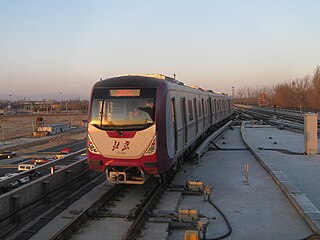
All Beijing Subway trains run on 1,435 mmstandard gauge rail and draw power from the 750 V DC third rail, except those on Lines 6, 11 14, 16, 17 and 19, which use 1,500 V DC overhead wires. Lines 6, 15, Fangshan, and Changping lines have a designed maximum service speed of 100 km/h (62 mph). The Airport Line is linear motor driven with a designed maximum service speed of 110 km/h (68 mph) All other Lines have a maximum service speed of 80 km/h (50 mph). Currently, Lines 1, 2, 4, 5, 8, 9, 10, 13, 15, Batong, Daxing, Changping, Fangshan, Yanfang, and Yizhuang lines use 6 car B size trains. Initially, the Batong line and Line 13 was originally used 4 car trains and now expanded into six.
The Hohhot–Nanning corridor is a proposed high-speed railway in China running from Hohhot in Inner Mongolia to Nanning in Guangxi. It will pass through the cities of Taiyuan, Zhengzhou, Xiangyang, Changde, Yiyang, Shaoyang, Yongzhou and Guilin. The corridor is one of the sixteen railway lines proposed under the "eight horizontal and eight vertical" railway network introduced in 2016.

Hexie, also known as the CRH series EMU, is an umbrella term for the multiple unit high-speed and higher-speed trains operated by China Railway under the China Railway High-speed brand. All series of Hexie are based on foreign-developed technology and later manufactured locally in China through technology transfer licenses, with the ultimate goal of China acquiring the know-how and capability to produce high-speed rail trains.

The CR200J Fuxing is a Chinese higher-speed trainset consisting of a power car paired with unpowered passenger cars operated by China Railway. It is the slowest member of the Fuxing series. The train was jointly designed and produced by six companies under CRRC.

The DK4 are a class of electrical multiple units built by Changchun Railway Vehicles, operated on the Pyongyang Metro, and later the Korean State Railway. The sets developed in parallel with the DK3, and these sets were delivered new to the Pyongyang Metro when it opened in September 1973, although they have since almost entirely disappeared from the metro network, with many sets being converted to be used under overhead catenary as electric multiple units, or as a locomotive.

The DDJ1 is a first generation high-speed electric multiple unit built for China Railway, built by Zhuzhou Electric Locomotives, Changchun Railway Vehicles, Sifang Railway Vehicles, Tangshan Passenger vehicle factory, Nanjing Puzhen and developed by Zhuzhou Electric Locomotive Research Centre. It was built in 1999, and was an experimental vehicle, with only one set built, as it did not enter mass production. The design was well received as part of national science in the 9th five year plan. The DDJ1 is in a push–pull configuration, with only one locomotive in the set and the other end being a trailer with a driver's cabin.

The NZJ "Lushan", also registered as the NZJ1 are a class of diesel multiple unit (DMU) of China Railway. These sets were built by Tangshan Locomotive in a 2M2T layout of four cars with Cummins diesel engines and Siemens electrical equipment. Three sets were built in total between 1998 and 2000, with two operated by Nanchang Railway Bureau and one by Kunming Railway Bureau.
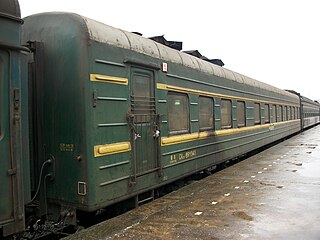
The China Railways Type 23 are a group of somewhat related carriages that are a class of the China Railways Type 22 carriage series, as they were a series of derivative carriages from the Type 22, rather than an independent class of carriages.

The DJF2"Xianfeng" electric multiple unit is a model operated formerly by China Railway with traction motors distributed throughout the unit. It was developed in 2001 as a key task of the science and technology targets of the Ninth Five-Year Plan. It was an innovative and advanced design being the first Chinese multiple unit train to achieve 200 km/h (124 mph) and achieving a top test speed of 292.8 km/h (181.9 mph) in tests, but had numerous flaws in the design that complicated operations.
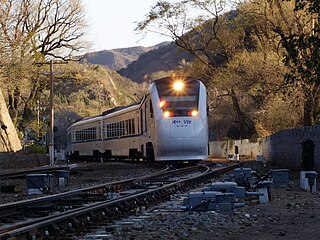
The NDJ3 "Great Wall", previously labeled the "Harmony Great Wall" is the only higher-speed diesel multiple unit that is still operating in China. It was first designed to be used for passenger transport in the 2008 Olympics, and has become a mature technology platform with export orders to Nigeria despite initial flaws related to overheating of electrical cables in the power car.
The TSD09 diesel multiple unit is a tilting train developed by Tangshan Locomotive in 2003 and fitted with Cummins diesel engines, Voith hydraulic transmission and Extel Systems Wedel tilting mechanisms. It was built for Sanmao Railway, but due to strategic reasons within the Ministry of Railways, the set never operated commercially and has been permanently stored at Tangshan Locomotive.
The KDZ1 is the first electrical multiple unit built in China. It is an experimental alternating current electrical multiple unit, developed by Changchun Railway Vehicles, CRRC Zhuzhou Institute and China Academy of Railway Sciences in 1978 and completed in 1988, though it never saw passenger service, with it being stored after it completed its initial tests.
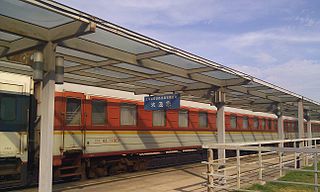
The Type 24 is a class of two unrelated carriages of China Railway. The two different types can be separated into those built in 1966 for air conditioned services on the Guangshen railway and those imported in the 1980s from East Germany, which consisted mostly soft seaters, but also a few hard sleepers.
The DJF1 "Zhongyuan Star" was an electric multiple unit of China Railway. It only operated in service for less than five years, before it was removed from service due to its various flaws and high maintenance costs. The train was initially built as a six car set, and subsequently lengthened to a fourteen car set. The two driving motors and the middle two motor cars have been preserved, with the other carriages being scrapped.
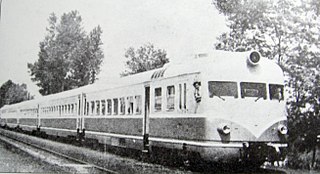
The NC3 are a model of diesel multiple units operated by China Railway. They were built by Ganz-MAVAG in 1962 and imported from the Hungarian People's Republic to be operated in China. They were not the first DMU to be operated in China; the Dongfeng DMU had been built a few years earlier, but only in a single set.














